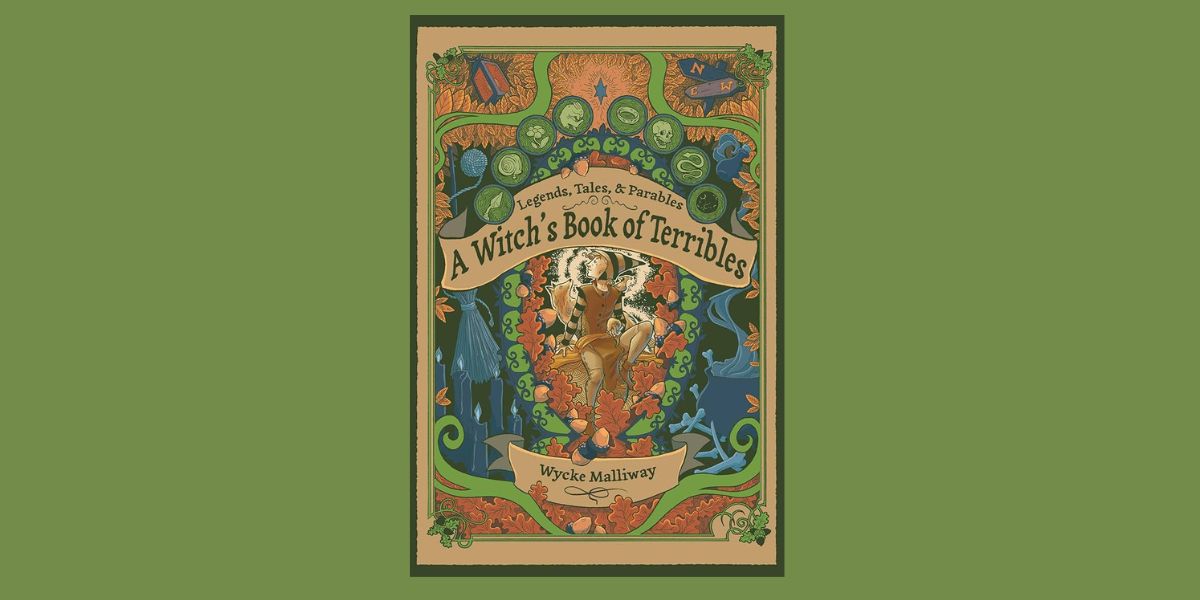
A Witch’s Book of Terribles: Legends, Tales, & Parables, by Wycke Malliway
Crossed Crow Books, 1959883054, 212 pages, March 2025
Just what is a witch? This is a question many of us who identify as one ponder. And while it’s very important to look within when deciding what flavors our witchcraft, we can’t help but be shaped by the stories about witches too. What secret wisdom might we glean? A Witch’s Book of Terribles: Legends, Tales & Parables by Wycke Malliway in an invitation to indeed look at the acts of other witches beyond the typical stereotypes, learn from their stories, and in turn discover more about the path we walk.
The witch is not a single figure; she is a mosaic of mysteries. In some stories, she is the feared outcast, cloaked in shadow and power. In others, she is the wise woman, healer, and midwife to transformation. These layers of identity–dark and light, feared and revered–mirror the inner complexity of every witch walking a magical path today. Within this book, each story is an invitation to meet a new part of ourselves.
Malliway’s “home-cooked folklore”1 is a really fun read! To be honest, I didn’t realize prior to beginning this book that she crafted all the stories herself, but I was thrilled once I found out. I love creative writing! In the introduction, Malliway describes:
“I’ve fumbled and grumbled through a lot in my own craft and have heard plenty of curious tales from other witches as well. I hope to pass on these magical beliefs, practical applications, and personal warnings through the experiences of witches in this book.”2
Malliway has written nine main stories, which vary in length, along with nine one-page poems. Some of the tales are quick reads, while others really invite you to sit with the book and delve in with care. I enjoyed the way the poems come between stories, giving my mind a rest to engage with the shorter text.
Another thing that makes this book very entertaining to read is all the images throughout. On nearly every page there’s at least one illustration, which the text wraps around, that kept me engaged. Admittedly, sometimes they’d make my mind wander, but I feel like this liminal state of daydreaming created a more receptive state for reading the tales.
I have no idea why, but this book really reminded me of the series Scary Stories to Tell in the Dark, which I was an avid reader of as a child. While intended for adults, there’s a childlike quality to the tales too, as it’s often younger folks learning the lessons.
One of my favorite stories was Ditty Denna and the Dismal Duenna, as I could really relate to Denna feeling left out of the more traditional magic while simultaneously enjoying her own brand of magic. In this tale, Denna, the youngest of six sisters, is often left out of the magic workings her sisters are crafting together. While her sisters all do things by the spell book, Denna is left to her own devices, left muttering:
“My magic does too work!” she mumbled to herself. “It’s just different.”3
Yet when her five older sisters summon an unfriendly fairy with their spell gone wrong, it’s Denna’s magic that is able to save them all. This story was very fun and a great reminder that it’s okay to do things your own way. You don’t need to be fenced in by the rules and expectations of others; you have your own potent magic within you!
Actually in quite a few of these stories, the witch is sought by the mundane folks, only to be mistreated. In quite a few stories, the greatest lesson was learning how to stand in one’s power and not succumb to the needs of others over honoring oneself.
These tales were fun, mysterious, and even spooky at times. Malliway definitely has her own style, and it was a good time reading folklore and tales that are not bogged down with the ancient history of “once upon a time.” These stories have a freshness to them, allowing readers to retell them in their own way to be passed along and shapeshifted through time and space, as the greatest stories tend to be.
The real magic in this book is that when we work with stories as witches, we don’t just consume the tales — we enter them. And in doing so, we reclaim each version of the witch — and each version of ourselves. Malliway has offered some explorative pathways to venture through in these tales, some for the better and some for worse. We are given the opportunity to gain wisdom and avoid pitfalls, if we can decipher the message.
Overall, for those who enjoy creative writing and poetry, A Witch’s Book of Terribles has a lot to offer. No doubt each reader will have their own takeaway from the changes, which will most likely change with each reading. Malliway’s versatile tales are ones that readers can come back to again and again to discover something new.
Alanna Kali is an astrologer, numerologist, and pioneer spirit that loves to explore life through the lens of depth psychology. She has a passion for studying the humanities and social trends. Her academic work is centered upon reuniting body, mind, and spirit through eco-psychology. She loves reading, spending time in nature, and travel.
